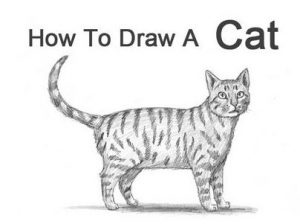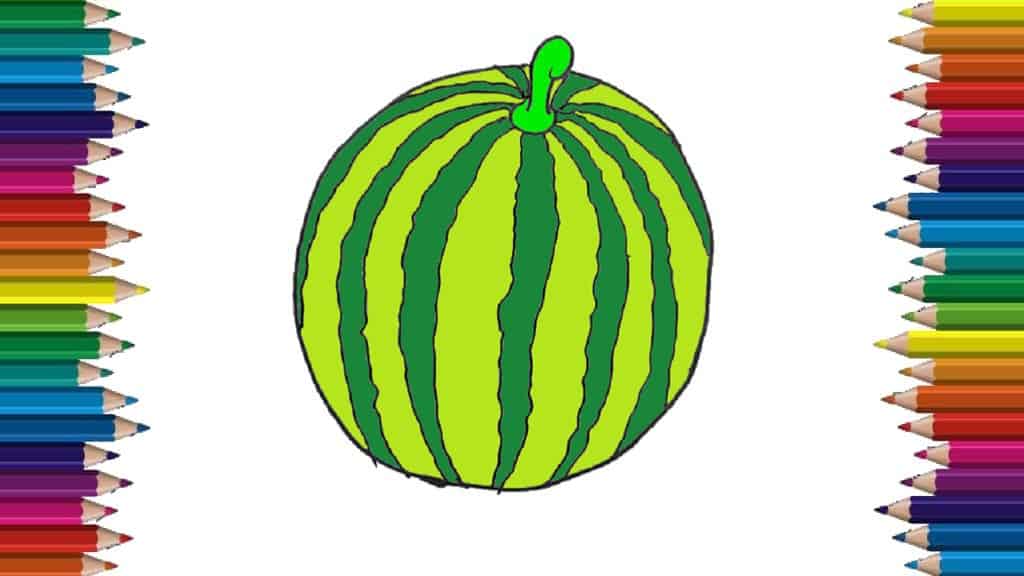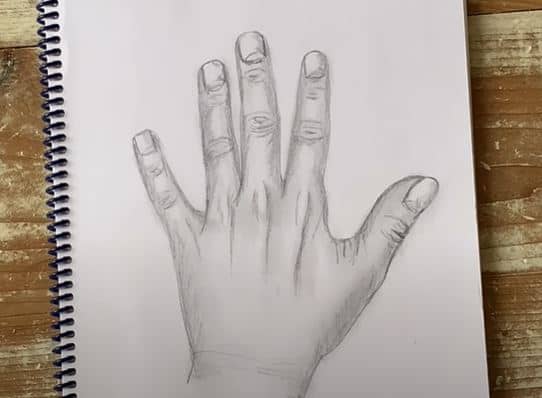How to draw A Tabby Cat easy with this how-to video and step-by-step drawing instructions. Cat drawing for beginners and everyone.

Please see the drawing tutorial in the video below
You can refer to the simple step-by-step drawing guide below
Step 1: Build the cat’s main organ
If you’ve followed any of our other animal drawing tutorials, you’ll know that we always start with building lines. Construction lines are extremely useful for any artist, whether you are a proficient artist or a beginner. Starting a drawing with building shapes and lines is a great way to make sure your dimensions are perfect before you start adding details. For our cat drawing, we’ll start with an oblong oval. Ideally, this oval should slant slightly to the right.
The most important part of this first step is making sure that your oval is in the center of your canvas. There are many other elements to the cat, including the head, tail, and legs, that you will draw in the next few steps, and these need a lot of space.
Step 2: Build Cat’s Head
In this second step, you will use another construction oval to represent the head of your one-cat drawing. The head oval should be much smaller than the body oval you drew in the last step, and it should have a steeper angle to the right.
Step 3: Create the cat’s first front paw
The next part of the cat’s body that you need to create is the front legs. The foot we are starting to be is the front foot furthest from us. Because of this angle, you can start the lines for the legs just above the oval of the body. At the bottom of the main body oval, just after the front point, draw two lines extending to the front. You want the two lines to be closer together when they reach the bottom.
At the bottom of this leg, draw a small oval with an upward angle. You will use this oval to draw the cat’s paw in the following steps.
Step 4: Build the cat’s second front leg
In this fourth step, use the same process as you did for the third step. However, for this front leg, you need to draw the lines straight down, rather than forward. Add a little uneven circle at the bottom of this leg to represent the leg.
Step 5: Build the cat’s first hind legs
This step and the next focus on drawing the first hind leg in your cat drawing. Start this back leg right in front of the back of the oval body. Draw a square “U” shape facing the back. Cats’ hind legs have knee joints, so it’s easier to draw this paw in two stages. This first build shape will represent the cat’s thighs.
Draw the Cat 5 To complete the bottom of the latter’s legs, draw two slightly slanted lines back and end the paw with an irregularly rotated circle.
Hopefully you can now see the shape of the hind leg and in the next few steps we will start butchering it.
Step 6: Build the cat’s second hind leg
For the second rear foot, you will follow the same basic steps as you did for the first rear foot. Start with another square “U” shape, but draw this one straight down, not back. You want to make sure that the back line of this “U” shape starts on the “U” shape of the other leg, to capture the right perspective.
To complete this final back leg, you’ll use two short lines and an uneven circle. To capture the correct angle of the cat’s hind legs, you want these two lines to point towards the front of the cat’s body. You also want to make sure that the circles are unevenly facing forward.
At this stage of the tutorial on how to draw a realistic cat, you will start to see your cat’s basic shapes come together and it will look like our example below.
Step 7: Create a cat’s tail
Now it’s time to draw the construction line that you will use to draw the tail. For the tail, you can simply use a single curved line, extending from just above the rear point of the body oval. For that characteristic curved tail, draw the line so it looks a bit like the letter “2.”
Step 8: Draw your cat’s ears
This is the final building step before we move on to creating the final sketch of your cat drawing. The perfect spot for a cat’s ears is right on top of its head, just behind the top of the oval on its head. Start by drawing a pointed triangle on top of the cat’s head oval, then draw a slightly more rounded shape behind it.
You want to make sure that the front ear overlaps the back ear to get the right perspective.
Step 9: Line your cat drawing carefully
After all these steps using construction lines, it’s finally time to put them to use and draw the final outline of your cat drawing. The best place to start your sketch is at the beginning. Using the oval to help you, line the ears and then flatten the top of the head slightly, before tapping down on the oval. You can then trace the bottom curve of your head, creating a slight volume for the nose. After you have outlined the chin, take the horizontal line to meet the main body oval just below the front point.
You can follow the other construction lines pretty closely for the rest of the outline. For the cat’s tail, outline the construction line on the sides. Don’t be afraid of not sticking to the construction lines perfectly, a few bumps and curves will add texture and realism to your drawing of a cat.
You can use short hair-like strokes to complete some outlines to give the impression of fur. Specifically along the belly, you can make the hair lines a little longer. For more realism, draw a few curved lines to separate the toes in the foot.
Once you are satisfied with your outline, you can erase all remaining construction lines.
Step 10: Add Texture and Details
Now that you’ve drawn the outline, you can move on to adding texture and details to the face. This step is the first of two detailing steps, and the second step will be done with paint.
To create an eye for your cat drawing, start by drawing a slanted “V” and add a half circle inside of it. After you’ve drawn the circle, fill in a smaller circle to create the iris. Use a few very small strokes to create a small eyebrow above the eye, and do the same below the eye for texture. Add some small lines to represent the nostrils, and around the nose you can draw some whiskers.
Across the rest of the cat’s body, use short strokes to give the impression of fur.
Step 11: Add the first color layer
The painted cat is a tabby, but if you want to capture the unique color of your pet, this is the step for you to have artistic freedom. If you are going to color your cat, you can follow along with us and use light brown as the base color for the whole body.
You want the first coat to be light, as you’ll be using a few darker shades to add texture over the next few steps.
Step 12: Add a second color layer
For this next coloring step, you need to choose a light gray color. Coat this very light coat over most of the cat’s body, leaving areas of light brown shade around the nose, under the belly, and around the cat’s legs.
At the end of this step, the cat’s color should look something like this.
Step 13: Blend the shades and add a third color layer
Using a soft, light brush add a third layer of slightly darker brown color. Again, like gray, you want to focus most of this brown on the top half of the cat, leaving lighter brown shades on the bottom.
For a realistic fur effect, you can make this coat a little more patchy. The lighter and darker patches of color make your cat drawing more realistic.
Step 14: Add Tabby Stripes
Tabby cats are known for their tiger-like stripes, and so to make your drawing more realistic, you can use a darker gray or black color to create these stripes. You want your stripes to be very narrow and fairly parallel. However, you don’t want to have pure parallel stripes all over the cat’s body. Make some of your lines slightly curved, put some in a different direction, and make sure none of them are joined together.
To make the stripes on the tail and legs look realistic, draw them horizontally so that they wrap around the legs and tail.
Step 15: Add featured content
To make any drawing look realistic, it is essential that you add highlights and shadows. These two tools help provide dimension and perspective to your drawing. Using a light cream color, trace some of your tiger stripes, to help contour your cat’s look. You can use cream color to blend lighter colored areas under the cat’s belly and face and along the upper part of the cat’s back.
When it comes to adding lights, it can be helpful to decide where your light source will be in your composition. For example, if your light source is above the cat’s head, you can add highlights to the top of the cat’s head, along its back and tail.
Step 16: Adding Shading
In this final step, you are going to use a shadow shade of dark grey or black to do the opposite of what you did for the highlighting. Add general shading on the parts of the cat’s body that would be shielded from your light source, like under the eyes, on the back of the neck, behind the legs, on the tail, and on the inside of the legs.


